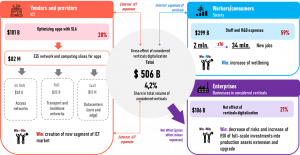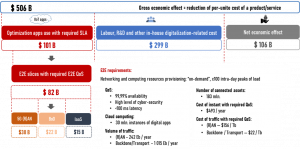Gross economic outcome from digitalization of key verticals of US economy may reach $506 bln. by 2030
J’Son&Partners estimated outcome of key industries digitalization: it will reach $506 bln. by 2030, while external ICT-expenses will exceed $101 bln.
MOSCOW, RUSSIA, October 19, 2021 /EINPresswire.com/ -- J’Son & Partners Consulting, a leading analytical and research and consulting company specialized in technology projects and markets, has estimated possible outcome for the US economy of key industries digitalization and assessed technical and economic requirements to 5G and next-generation ICT infrastructure.Estimations show that the annual volume of economic outcome may reach $506 bln. by 2030 for key industries of the US economy, while external ICT expenses on digital apps, 5G, and other infrastructure provided as a service will exceed $101 bln. The volume of internal digitalization-related expenses will reach almost $300 bln., which will create 34 mln. new jobs — 2 mln. directly and 32 mln. via multiplication effect.
However, positive net profitability of verticals’ digitalization will be achieved only if mobile telcos offer M2M traffic with deterministic SLA of 99,99% at a unit cost 30 times lower than current best-effort traffic with no SLA. These requirements can be met only with next-generation infrastructure in all ICT domains.
Industrial usage, especially in key verticals such as mining, manufacturing, logistics, wholesale, transport, and retail, is critical for the commercial success of 5G, multitenancy edge computing, and other domains of next-generation ICT infrastructure. The source of revenue here is an economic outcome from digitalization, while related expenses should not exceed the outcome. Therefore prior to designing tailored ICT services, it is essential to assess acceptable values of specific ICT parameters meeting both technical and economic requirements of digital applications, infrastructure, and related expenses.
An estimated $506 bln. of gross economic effect from key verticals’ digitalization is to be achieved by 2030 with the connection of 183 mln. of assets to digital applications. If telcos offer M2M traffic with deterministic SLA of 99,99% at a unit cost 30 times lower than current prices for best-effort traffic, the net economic effect will be positive reaching $106 bln. in 2030 – refer to Figure 1. Internal expenses of verticals will reach almost $300 bln. creating 2 mln. of new high-tech jobs.
This means that the net profitability of digitalization is achieved without huge upfront capital investments into industrial assets replacement or upgrade. In the first stage, verticals are to replace legacy management systems with digital ones, provided under aaS model, i.e. recurrent payments will be covered by regular economic effect. Therefore, full-scale digitalization can be launched without huge upfront investments, while net profitability will allow to improve the ROI of the second stage — upgrade of assets. However, investments into 5G and other next-generation ICT infrastructure deployment are needed already in the first stage to enable telcos to decrease per-unit costs radically and to remain profitable, while providing the required SLA.
Another important point is that outcome from digitalization is distributed unevenly and doesn’t correspond to the vertical volume. The major part — almost 50% of total gross economic effect — comes from transport and logistics, as the most receptive to digitalization. Production industries together generate less than 30% of outcome, while retail — the major sector of the US economy — is responsible for merely 5%. Construction and utilities cover 14% and 6% respectively.
The first stage of digitalization should be net profitable for a major part of industries in case of a dramatic decrease of the per-unit cost of M2M traffic. The only exception is retail with $9 bln. net loss due to extraordinary expenses on consumers’ behavior data collection and analysis, so it calls for the elaboration of the cross-vertical mechanism of net economic effect distribution between retail and other verticals, first of all between retail and transport & logistics.
Moreover, net profitability of digitalization is achievable only if telcos meet two contradictory requirements:
• Radical decrease of M2M traffic cost,
• Ability to meet strict SLA requirements instead of the best-effort principle of services provisioning.
According to estimations made by J’son & Partners Consulting, per unit cost of 1 TB of M2M traffic via radio access networks should not exceed $3400 and $33 via optical access networks ($156 average). Strict SLA requirements are to be applied to industrial application traffic — such as 99,99% availability combined with on-demand bandwidth provisioning for load peaks, end-to-end traffic isolation, and sophisticated cyber security. Currently, the unit cost of best-effort M2M traffic is $101 thsd. for mobile and $150 for fixed optical access networks ($556 average), while SLA is not provided in most cases. In order to solve this telcos need to deploy next-generation ICT infrastructure in mobile and other domains based on SDN and NFV technologies, enabling flexible intra- and cross-domain orchestration for radical improvement of networking and computing resources utilization.
All estimations are implemented using original methodology by J’son & Partners Consulting:
• Sustainability is crucial for successful digitalization, so all parties involved in digitalization must win. A win-lose game is not considered.
• Assessment of economic outcomes must be conservative: effects due to replacement or upgrade of existing assets are not considered. Price-dependent growth of sales is not considered as well.
• Optimization management is provided by specific digital applications, implying specific requirements on computing and networking infrastructure to be met by computing network slices.
• Digital applications and ICT infrastructure are provided under aaS model, which allows eliminating lag between spending and outcome.
• Volume of internal digitalization-related expenses is calculated using the typical structure of a corporate IT project, where internal labor-related expenses may reach 70% of the budget, i.e. of economic outcome.
J'son & Partners Consulting is using its own outcome-based methodology to estimate the target economic and technical parameters of industrial E2E slices. Visit the website for more details and calculations.
J'son & Partners Consulting is one of the leading consulting companies in Technology, Media, Telecommunications and Financial Services, with extensive experience in developing and auditing business plans, marketing, developing financial models, as well as in-depth research of markets in Russia and CIS countries.
Alexander Gerasimov
J'son & Partners Consulting
+7 916 601-84-89
agerasimov@json.ru
Legal Disclaimer:
EIN Presswire provides this news content "as is" without warranty of any kind. We do not accept any responsibility or liability for the accuracy, content, images, videos, licenses, completeness, legality, or reliability of the information contained in this article. If you have any complaints or copyright issues related to this article, kindly contact the author above.


